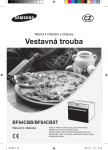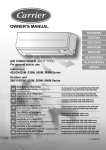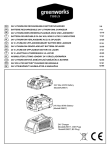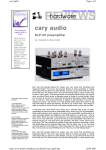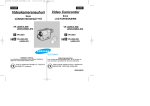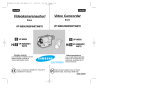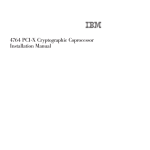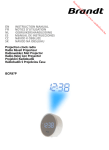Download IBM SecureWay Cryptographic Products IBM 4758 PCI
Transcript
IBM SecureWay Cryptographic Products IBM 4758 PCI Cryptographic Coprocessor Installation Manual Security Solutions and Technology Department IBM Corporation 8501 IBM Drive Charlotte, North Carolina 28262-8563 Lithium Battery Safety Caution: A lithium battery can cause a fire, an explosion, or a severe burn. Do not recharge, disassemble, heat above 100 degrees C (212 degrees F), solder directly to the cell, incinerate, or expose the cell contents to water. Keep away from children. Replace only with the part number specified for this IBM product. Use of a different battery may present the risk of fire or explosion. The battery connector is polarized; do not attempt to reverse the polarity. Dispose of the battery according to local regulations. Advertencia Una batería de litio puede causar incendios, explosiones o quemaduras graves. No recargar, desmontar, calentar por encima de los 100 grados C (212 grados F), soldar directamente sobre la pila, incinerar o poner en contacto con el agua el contenido de la misma. Mantenga fuera del alcance de los niños. Sustituir por el número de pieza especificado para este producto de IBM. Usar una pila diferente puede suponer un riesgo de incendio o explosión. El conector de la batería está polarizado. No intente invertir la polaridad. Deshágase de la batería de acuerdo con las disposiciones municipales. Attenzione: Una batteria al litio potrebbe incendiarsi, esplodere o procurare gravi ustioni. Non ricaricarla, non smontarla e non riscaldarla ad una temperatura superiore ai 100 gradi, non saldarla, non incinendiarla e non gettarla in acqua. Tenerla lontana dalla portata dei bambini. Sostituirla soltanto con una batteria contrassegnata dal numero parte specifico per questo prodotto IBM; l'utilizzo di un'altra batteria può determinare rischi di incendio o di esplosione. Il connettore della batteria è polarizzato; non tentare di invertire la polarità. Smaltire la batteria seguendo la normativa in vigore (DPR915/82 e successive disposizioni e disposizioni locali). vi IBM 4758 PCI Cryptographic Coprocessor Installation Manual VARNING: Ett litiumbatteri kan orsaka brand, explosion eller allvarlig brännskada. Det får inte återladdas, tas isär, utsättas för temperaturer över 100°C eller brännas. Löd inte direkt på battericellen och låt inte cellinnehållet komma i kontakt med vatten. Förvara batteriet oåtkomligt för barn. Byt endast till batteri med angivet artikelnummer för den här IBM-produkten. Användning av annat batteri kan medföra brand- eller explosionsrisk. Batterianslutningen är polariserad. Försök inte växla polaritet. Följ lokala föreskrifter vid kassering av batteriet. Safety Information—Read This First vii 2. 3. 4. viii IBM 4758 PCI Cryptographic Coprocessor Installation Manual Varoitus: Litiumpariston väärä käsittely voi aiheuttaa tulipalo- tai räjähdysvaaran tai palovammoja. Älä lataa paristoa uudelleen, äläkä pura paristoa osiin. Älä kuumenna paristoa yli 100 °C:n lämpötilaan tai hävitä sitä polttamalla. Estä paristoa joutumasta kosketuksiin veden kanssa. Pidä paristo poissa lasten ulottuvilta. Pariston saa vaihtaa vain paristoon, joka on osanumeron perusteella tarkoitettu tähän IBM:n tuotteeseen. Muunlaisen pariston käyttö voi aiheuttaa tulipalo- tai räjähdysvaaran. Älä yritä vaihtaa pariston napaisuutta. Hävitä paristo ongelmajätteistä säädettyjen lakien ja viranomaisten määräysten mukaisesti. Safety Information—Read This First ix Výstraha Lítiová batéria može spôsobi oheň, exploziu, alebo samovznietenie. Nedobíjajte, nedemomtujte, nevystavujte teplotám nad 100°C (212°F), nespájkujte priamo na článku, nespa+ujte a nevystavujte obsah článkov vode. Držte mimo dosahu detí. Nahrádzajte jedine dielmi prípustnými pre váš systém. Použitie iných batérií predstavuje riziko požiaru alebo výbuchu. Konektor batérie je polarizovaný; nepokúšajte sa zameni polaritu. Používajte batériu zodpovedajúc miestnym pravidlám. Cuidado: Uma bateria de lítio representa um risco de incêndio, explosão ou queimaduras graves. Não a recarregue, não a desmonte nem exponha a temperaturas superiores a 100°C (212°F), não efectue soldaduras directas, não a incinere nem exponha o interior ao contacto com água. Mantenha-a afastada das crianças. Quando a substituir, faça-o somente por uma bateria cujo número de referência seja o especificado para este produto IBM. A utilização de uma bateria diferente apresenta o risco de incêndio ou explosão. O terminal da bateria está polarizado. Não tente inverter a polaridade. Destrua a bateria de acordo com a regulamentação do país. Achtung: Lithiumbatterien sind feuergefährlich, explosiv und können schwere Verbrennungen verursachen. Batterie nicht wiederaufladen, öffnen oder über 100 Grad Celsius erhitzen; die Zelle nicht direkt anlöten, verbrennen oder den Inhalt der Zelle mit Wasser in Berührung bringen. Batterie nicht in Reichweite von Kindern aufbewahren. Eine verbrauchte Batterie nur durch eine Batterie mit der für dieses System spezifizierten Teilenummer ersetzen. Andere Batterien können sich entzünden oder explodieren. Der Batterieanschluß hat zwei verschiedene Pole; beim Anschließen die Pole nicht vertauschen. Batterie gemäß den örtlichen Richtlinien für Sondermüll entsorgen. x IBM 4758 PCI Cryptographic Coprocessor Installation Manual Pas på! Litiumbatteriet kan forårsage brand og eksplosion og give alvorlige brandsår. Det må ikke genoplades, åbnes, udsættes for mere end 100 grader, brændes eller komme i berøring med vand. Batteriet skal opbevares utilgængeligt for børn. Det må kun udskiftes med et litiumbatteri, der har det partnummer, der er angivet til dette IBM-produkt. Bruges en anden batteritype, kan det medføre eksplosion eller brand. Batteripolen er polariseret. Forsøg ikke at bytte om på polerne. Batteriet skal kasseres i henhold til de lokale bestemmelser. Spørg kommunens tekniske forvaltning (miljøafdelingen). Waarschuwing: De lithiumbatterij is brand- en explosiegevaarlijk en kan ernstige verbrandingen veroorzaken. Laad de batterij niet opnieuw op, demonteer hem niet, stel hem niet bloot aan temperaturen hoger dan 100 graden Celsius (212 graden Fahrenheit), soldeer niet direct op de cel, verbrand hem niet en stel de inhoud van de cel niet bloot aan water. Buiten bereik van kinderen houden. Vervang de batterij alleen door een batterij met het onderdeelnummer dat voor dit IBM-product is gespecificeerd. Gebruik van een andere batterij kan brand of explosie van de batterij tot gevolg hebben. De batterij-aansluiting maakt gebruik van polen. Verwissel de polen niet. Lever de batterij in bij een inzamelpunt voor klein chemisch afval. Cuidado: Uma bateria de lítio apresenta risco de incêndio, explosão ou queimaduras graves. Não recarregue, desmonte, nem exponha a bateria a temperaturas superiores a 100 graus C (212 F), não a solde diretamente na célula, não a incinere nem exponha o conteúdo da célula à água. Mantenha fora do alcance de crianças. Substitua apenas pelo número de peça especificado para este produto IBM. O uso de uma bateria diferente pode apresentar risco de incêndio ou explosão. O conector da bateria é polarizado; não tente inverter a polaridade. Destrua a bateria de acordo com a regulamentação local. Safety Information—Read This First xi Attention Prenez garde aux risques d’incendie, d’explosion ou de brûlures graves liés à l’utilisation d’une pile au lithium. Ne rechargez pas la pile et ne la démontez pas. Ne l’exposez pas à une température supérieure à 100 °C, ne la soudez pas, ne la faites pas brûler et n'en exposez pas le contenu à l’eau. Gardez la pile hors de portée des enfants. Si vous la remplacez, commandez une pile de rechange de même référence. Toute autre pile risquerait de prendre feu ou d'exploser. Le connecteur de la pile est polarisé. N’essayez pas d’inverser la polarité. Ne mettez pas la pile à la poubelle. Pour le recyclage ou la mise au rebut, reportez-vous à la réglementation en vigueur. xii IBM 4758 PCI Cryptographic Coprocessor Installation Manual About This Manual The IBM 4758 PCI Cryptographic Coprocessor Installation Manual is written for personnel installing the IBM 4758 PCI Cryptographic Coprocessor hardware. How This Manual Is Organized This manual is organized as follows: Saftey Information — Read This First Chapter 1, “Introduction,” describes the shipping, handling, and operating requirements of the PCI Cryptographic Coprocessor. Chapter 2, “Installing the Coprocessor,” describes the way to install the PCI Cryptographic Coprocessor. Chapter 3, “Replacing Coprocessor Batteries,” describes the way to replace the batteries on the PCI Cryptographic Coprocessor. Appendix A, “Notices and Product Warranty,” contains notices for various countries and information about the product warranty extended by IBM. A list of abbreviations, a glossary, and an index completes the manual. Where to Find More Information Visit the IBM 4758 product website at http://www.ibm.com/security/cryptocards to obtain IBM 4758-related publications. This and other publications are available as Adobe** PDF files that you can read and print with the Adobe Acrobat Reader. Copyright IBM Corp. 1997-2000 xiii xiv IBM 4758 PCI Cryptographic Coprocessor Installation Manual Chapter 1. Introduction This chapter details the contents of the Coprocessor Package, and describes the following information: Special considerations for handling and storage Requirements and specifications The IBM 4758 PCI Cryptographic Coprocessor uses dedicated hardware to process cryptographic keys, certificates, and bulk data. These cryptographic functions are performed within a tamper-resistant module that is designed to meet the FIPS PUB 140-1 specification for detecting attacks through temperature, radiation, voltage, and physical penetration. Model 001 is certified at level 4 of the standard. Model 013 is certified at level 3 of the standard. Models 002 and 023 build on the designs of models 001 and 013 and are under evaluation at levels 4 and 3 of the standard, respectively. You can install the Coprocessor—a standard, two-thirds length PCI card—in an RS/6000* workstation, or in an IBM-compatible computer with a PCI expansion slot available. Contents of the Coprocessor Package Your package includes the following items: The IBM 4758 PCI Cryptographic Coprocessor The Caution: Safety Information—Read This First, SD21-0030 booklet A product-support information insert. If any item is missing or damaged, contact your local IBM representative or your IBM Business Partner. OEM customers in the United States should call 1-800-IBMS-OEM (1-800-426-7636). Special Considerations for Handling and Storage Each IBM 4758 PCI Cryptographic Coprocessor is shipped from the factory with a certified device key. This electronic key—stored in the card's battery-powered protected memory—digitally signs test messages to confirm that the PCI Cryptographic Coprocessor is genuine and that no tampering has occured. Note: If any of the secure module’s tamper sensors are triggered by tampering or accident, the Coprocessor erases all data in the protected memory, destroying the device key. The PCI Cryptographic Coprocessor cannot operate without the device key. To protect the key, follow these guidelines: Temperature: Do not expose the Coprocessor to temperatures below −15 degrees C (+5 degrees F) or temperatures above 60 degrees C (140 degrees F). Batteries: Do not remove the coprocessor’s batteries. Data in the protected memory is lost when battery power is removed. For information about replacing the batteries without erasing the protected memory, see Chapter 3, “Replacing Coprocessor Batteries.” Copyright IBM Corp. 1997-2000 1-1 Requirements and Specifications Hardware: A personal computer, workstation, server, communication device or RS/6000 with a PCI (Version 2.1) bus slot available. No additional hardware or cabling is required. Software: The Coprocessor requires support software—like the IBM 4758 CCA Support Program—for both the host machine and for its internal firmware. Operating system support is determined by the support software. This publication does not discuss the installation of support software. For information about the latest software features available, visit the product web site at http://www.ibm.com/security/cryptocards. Power and Environment: Power consumption, typical for models 002 and 023: 7.2 watts Power consumption, typical for models 001 and 013: 6.3 watts Voltage: +12.0 VDC, ± 5 percent +5.0 VDC, ± 5 percent Relative Humidity: 8 to 80% Temperature: Operating: 10 to 40 degrees C (50 to 104 degrees F) Storage: −15 to 60 degrees C (+5 to 140 degrees F) Physical Dimensions: The Coprocessor is a two-thirds length PCI card, 4.2 in. by 6.9 in. (106mm by 175mm). 1-2 IBM 4758 PCI Cryptographic Coprocessor Installation Manual Chapter 2. Installing the Coprocessor This chapter describes installing the IBM 4758 PCI Cryptographic Coprocessor. Before installing the Coprocessor, read the safety information in Caution: Safety Information—Read This First, SD21-0030 and read the compliance statements in “Electronic Emissions” on page A-1. To install the coprocessor into the host computer, follow these steps: 1 Locate your computer’s instructions for installing expansion cards. Throughout this procedure, follow the safety instructions in that manual. 2 Turn OFF the computer and all attached devices. 3 Disconnect all cables, including the power cable. CAUTION: Electrical current from power, telephone, and communication cables is hazardous. Disconnect cables before installing, moving, or opening the covers of any computer. To avoid electrical shock, do not connect or disconnect any cables during an electrical storm. 4 Remove the cover from the expansion slots according to the directions provided with your computer. 5 Choose a PCI expansion slot able to accommodate a two-thirds length card. 6 If the expansion slot has an individual cover, remove the bracket-holding screw and the cover. Attention: Electrostatic discharge (ESD) can damage the card and its components. Wear an ESD wrist-strap while handling and installing the card, or take the following precautions: Limit your movements; this helps prevent static electricity building up around you. Prevent others from touching the card or other components. Before removing the card from the anti-static bag, touch the bag to an unpainted metal surface on your computer and hold it there for at least two seconds. Handle the card by its edges only. Do not touch exposed circuitry and components. 7 Remove the PCI Cryptographic Coprocessor from its static-protective bag. 8 Verify that the jumpers on the card are positioned correctly; see Figure 2-2 on page 2-2. Copyright IBM Corp. 1997-2000 2-1 J2 Figure J3 J6 2-1. Jumpers on the PCI Cryptographic Coprocessor Figure 2-2. Jumpers on the PCI Cryptographic Coprocessor Jumper Number of Pins Name of Jumper Position When Shipped J2 2 PCI EPROM write-enable Shipped with jumper installed J3 4 Temporary battery connector Shipped without jumper installed J6 2 External-tamper-switch connector Shipped with jumper installed Note: Shipped with jumper installed means that the pins are connected. 9 Insert the coprocessor into the slot; be sure the card is fully seated. 10 If you removed a cover from the expansion slot, replace it. 11 Replace the host computer’s cover. 12 Reconnect the power cable and any other cables you disconnected. 13 Turn the computer ON. The PCI Cryptographic Coprocessor runs its power-on self-test (POST). You have completed the procedure for the physical installation of the PCI Cryptographic Coprocessor. Refer to the support software documentation for information about initializing and using the Coprocessor. 2-2 IBM 4758 PCI Cryptographic Coprocessor Installation Manual Chapter 3. Replacing Coprocessor Batteries This chapter describes the way to replace the batteries on the PCI Cryptographic Coprocessor. Before beginning the procedure, read the following descriptive and cautionary materials. Two lithium batteries mounted on the PCI Cryptographic Coprocessor supply power to the card’s components, including protected memory. Your support software or application software can query the Coprocessor to determine whether the batteries need to be replaced. When shipped from the factory, the protected memory contains a certified device key. If your Coprocessor has been initialized by support software, the protected memory contains secret data, including a master cryptographic key, user profiles, and user passwords. Attention: If you remove either of the batteries without first backing up the power with a fresh battery, the data in protected memory can be lost. The Replacement Battery Kit for the IBM 4758 PCI Cryptographic Coprocessor (Feature #1008) provides the battery tray needed to provide backup power while you replace the batteries. To order the kit, contact your local IBM representative or your IBM Business Partner. OEM customers in the United States should call 1-800-IBMS-OEM (1-800-426-7636). CAUTION: Before beginning the battery-replacement procedure detailed below, read the general safety information in Caution: Safety Information—Read This First, SD21-0030 and the lithium battery safety information under “Lithium Battery Safety” on page vi. Your Replacement Battery Kit should include: Two replacement batteries. A battery tray with connecting wires. To replace the batteries, follow these steps: 1 Turn OFF the computer and all attached devices. 2 Disconnect all cables, including the power cable. CAUTION: Electrical current from power, telephone, and communication cables is hazardous. Disconnect cables before installing, moving, or opening the covers of any computer. To avoid electrical shock, do not connect or disconnect any cables during an electrical storm. 3 Remove the cover from the expansion slots according to the directions provided with your computer. 4 Open the Battery Replacement Kit. Copyright IBM Corp. 1997-2000 3-1 Attention: Electrostatic discharge (ESD) can damage the card and its components. Wear an ESD wrist-strap while handling and installing the card, or take the following precautions: Limit your movements; this helps prevent static electricity building up around you. Prevent others from touching the card or other components. Handle the card by its edges only. Do not touch exposed circuitry and components. 5 Remove the PCI Cryptographic Coprocessor from the PCI-bus slot in the host computer. 6 Insert one of the new batteries into the battery tray provided with the kit. Align the “+” on the battery with the “+” on the battery tray (the end with the red wire). Connect the tray’s wires to the J3 connector located near the RS-232 serial port; see Figure 3-1. The connector is polarized to ensure a proper connection. BT2 J3 Figure 3-1. J3 Connector and Battery Locations on the PCI Cryptographic Coprocessor Attention: Any loss of power erases data stored in the card’s protected memory. To prevent loss, ensure that the battery tray contains a fresh battery and is attached to the J3 connector. 3-2 7 Remove the battery in the BT1 position. To eject the battery, turn the Coprocessor over and insert a small object, such as a screwdriver, through the hole to eject the battery. 8 Replace the battery in the BT1 position with a new battery. 9 Replace the battery in the BT2 position with the battery in the battery tray. (The new battery already installed in the BT1 position provides power to the PCI Cryptographic Coprocessor while you perform this step.) 10 Remove the battery tray from the J3 connector, and discard it. 11 Re-insert the Coprocessor into the PCI-bus slot; be sure the card is fully seated. 12 Replace the host computer’s cover. 13 Reconnect the power cable and any other cables you disconnected. IBM 4758 PCI Cryptographic Coprocessor Installation Manual 14 Turn the computer ON. The PCI Cryptographic Coprocessor runs its power-on self-test (POST). 15 The batteries are lithium 3 volt batteries. Recycle or dispose of the old batteries as required by local law. You have completed the procedure for replacing the PCI Cryptographic Coprocessor batteries. Chapter 3. Replacing Coprocessor Batteries 3-3 3-4 IBM 4758 PCI Cryptographic Coprocessor Installation Manual Appendix A. Notices and Product Warranty References in this publication to IBM products, programs, or services do not imply that IBM intends to make these available in all countries in which IBM operates. Any reference to an IBM product, program, or service in this publication is not intended to state or imply that only IBM’s product, program, or service may be used. Any functionally equivalent product, program, or service that does not infringe any of IBM’s intellectual property rights may be used instead of the IBM product, program, or service. Evaluation and verification of operation in conjunction with other products, programs, or services, except those expressly designated by IBM, are the user’s responsibility. IBM may have patents or pending patent applications covering subject matter in this document. The furnishing of this document does not give you any license to these patents. You can send license inquiries, in writing, to the IBM Director of Licensing, IBM Corporation, 500 Columbus Avenue, Thornwood NY 10594 USA. Trademarks The following terms, denoted by an asterisk (*) in this publication, are trademarks of the IBM Corporation in the United States or other countries or both: AIX IBM RS/6000 OS/2 Operating System/2 The following terms, denoted by a double asterisk (**) in this publication, are the trademarks of other companies: Adobe Acrobat Java Microsoft Windows NT Adobe Systems, Inc. Sun Microsystems Microsoft Corporation Microsoft Corporation Electronic Emissions Federal Communications Commission (FCC) Statement This equipment has been tested and found to comply with the limits for a Class B digital device, pursuant to Part 15 of the FCC Rules. These limits are designed to provide reasonable protection against harmful interference in a residential installation. This equipment generates, uses, and can radiate radio frequency energy and, if not installed and used in accordance with the instructions, may cause harmful interference to radio communications. However, there is no guarantee that interference will not occur in a particular installation. If this equipment does cause harmful interference to radio or television reception, which can be determined by turning the equipment off and on, the user is encouraged to try to correct the interference by one or more of the following measures: Copyright IBM Corp. 1997-2000 A-1 Reorient or relocate the receiving antenna. Increase the separation between the equipment and receiver. Connect the equipment into an outlet on a circuit different from that to which the receiver is connected. Consult an IBM-authorized dealer or service representative for help. IBM is not responsible for any radio or television interference caused by unauthorized changes or modifications to this equipment. Unauthorized changes or modifications could void the user’s authority to operate this equipment. This device complies with Part 15 of the FCC rules. Operation is subject to the following two conditions: (1) this device may not cause harmful interference, and (2) this device must accept any interference received, including interference that may cause undesired operation. Industry Canada Compliance Statement This digital apparatus does not exceed the Class B limits for radio noise emissions from digital apparatus as set out in the interference-causing equipment standard entitled: Digital Apparatus, ICES-003 of Industry Canada. Avis de conformité aux normes d'Industrie Canada Cet appareil numérique respecte les limites de bruits radioélectriques applicables aux appareils numériques de Classe B prescrites dans la norme sur le matériel brouiller: Appareils numériques, NMB-003 édictée par industrie Canada. Japanese Voluntary Control Council for Interference (VCCI) Statement This equipment is in the 2nd Class category (information equipment to be used in a residential area or an adjacent area thereto) and conforms to the standards set by the Voluntary Control Council for interference by Information Technology Equipment aimed at preventing radio interference in such residential areas. When used near a radio or TV receiver, it may become the cause of radio interference. Read the instructions for correct handling. A-2 IBM 4758 PCI Cryptographic Coprocessor Installation Manual Warranty IBM International Business Machines Corporation Armonk, NY 10504 Statement of Limited Warranty The warranties provided by IBM in this Statement of Limited Warranty apply only to Machines you originally purchase for your use, and not for resale, from IBM or an IBM authorized reseller. The term “Machine” means an IBM machine, its features, conversions, upgrades, elements, or accessories, or any combination of them. Machines are subject to these terms only if purchased in the United States or Puerto Rico, or Canada, and located in the country of purchase. If you have any questions, contact IBM or your reseller. Machine IBM 4758 PCI Cryptographic Coprocessor Warranty Period* One Year Production Status Each Machine is manufactured from new parts, or new and serviceable used parts (which perform like new parts). In some cases, the Machine may not be new and may have been previously installed. Regardless of the Machine’s production status, IBM’s warranty terms apply. The IBM Warranty IBM warrants that each Machine 1) is free from defects in materials and workmanship and 2) conforms to IBM’s Official Published Specifications. IBM calculates the expiration of the warranty period from the Machine’s Date of Installation. The date on your receipt is the Date of Installation, unless IBM or your reseller informs you otherwise. During the warranty period, IBM or your reseller will provide warranty service under the type of service designated for the Machine and will manage and install engineering changes that apply to the Machine. IBM or your reseller will specify the type of service. For a feature, conversion, or upgrade, IBM or your reseller may require that the Machine on which it is installed be 1) the designated, serial-numbered Machine and 2) at an engineering-change level compatible with the feature, conversion, or upgrade. Some of these transactions (called “Net-Priced” transactions) may include additional parts and associated replacement parts that are provided on an exchange basis. All removed parts become the property of IBM and must be returned to IBM. Replacement parts assume the remaining warranty of the parts they replace. If a Machine does not function as warranted during the warranty period, IBM in its sole discretion will repair, replace it (with a Machine that is at least functionally equivalent), or refund the purchase price. To obtain coverage under the warranty you may be required to present proof of purchase. This warranty is non-transferable by the end-user customer. Appendix A. Notices and Product Warranty A-3 Warranty Service To obtain warranty service for the Machine, you should contact your reseller or go to the support page on the &sitename. web site at http://www.ibm.com/security/cryptocards to report your problem. You may be required to present proof of purchase. Depending on the Machine, the service may be 1) a “Repair” service at your location (called “On-site”) or at one of IBM’s or a reseller’s service locations (called “Carry-in”) or 2) an “Exchange” service, either On-site or Carry-in. When a type of service involves the exchange of a Machine or part, the item IBM or your reseller replaces becomes its property and the replacement becomes yours. The replacement may not be new, but will be in good working order and at least functionally equivalent to the item replaced. It is your responsibility to: 1. obtain authorization from the owner (for example, your lessor) to have IBM or your reseller service a Machine that you do not own; 2. where applicable, before service is provided — a. follow the problem determination, problem analysis, and service request procedures that IBM or your reseller provide, b. secure all programs, data, and funds contained in a Machine, c. inform IBM or your reseller of changes in a Machine’s location, and d. for a Machine with exchange service, remove all features, parts, options, alterations, and attachments not under warranty service. Also, the Machine must be free of any legal obligations or restrictions that prevent its exchange; and 3. be responsible for loss of, or damage to, a Machine in transit when you are responsible for the transportation charges. Extent of Warranty IBM does not warrant uninterrupted or error-free operation of a Machine. Misuse, accident, modification, unsuitable physical or operating environment, improper maintenance by you, or failure caused by a product for which IBM is not responsible may void the warranties. THESE WARRANTIES REPLACE ALL OTHER WARRANTIES, EXPRESS OR IMPLIED, INCLUDING, BUT NOT LIMITED TO, THE IMPLIED WARRANTIES OF MERCHANTABILITY AND FITNESS FOR A PARTICULAR PURPOSE. HOWEVER, SOME LAWS DO NOT ALLOW THE EXCLUSION OF IMPLIED WARRANTIES. IF THESE LAWS APPLY, THEN ALL EXPRESS AND IMPLIED WARRANTIES ARE LIMITED IN DURATION TO THE WARRANTY PERIOD. NO WARRANTIES APPLY AFTER THAT PERIOD. In Canada, warranties include both warranties and conditions. Some jurisdictions do not allow limitations on how long an implied warranty lasts, so the above limitation may not apply to you. A-4 IBM 4758 PCI Cryptographic Coprocessor Installation Manual Limitation of Liability Circumstances may arise where, because of a default on IBM’s part (including fundamental breach) or other liability (including negligence and misrepresentation), you are entitled to recover damages from IBM. In each such instance, regardless of the basis on which you are entitled to claim damages, IBM is liable only for: 1. bodily injury (including death), and damage to real property and tangible personal property; and 2. the amount of any other actual loss or damage, up to the greater of $100,000 or the charge for the Machine that is the subject of the claim. Under no circumstances is IBM liable for any of the following: 1. third-party claims against you for losses or damages (other than those under the first item listed above); 2. loss of, or damage to, your records or data; or 3. economic consequential damages (including lost profits or savings) or incidental damages, even if IBM is informed of their possibility. Some jurisdictions do not allow the exclusion or limitation of incidental or consequential damages, so the above limitation or exclusion may not apply to you. This warranty gives you specific legal rights and you may also have other rights which vary from jurisdiction to jurisdiction. Appendix A. Notices and Product Warranty A-5 A-6 IBM 4758 PCI Cryptographic Coprocessor Installation Manual Glossary This glossary includes some terms and definitions from the IBM Dictionary of Computing, New York: McGraw Hill, 1994. This glossary also includes some terms and definitions from: The American National Standard Dictionary for Information Systems, ANSI X3.172-1990, copyright 1990 by the American National Standards Institute (ANSI). Copies may be purchased from the American National Standards Institute, 11 West 42 Street, New York, New York 10036. Definitions are identified by the symbol (A) following the definition. The Information Technology Vocabulary, developed by Subcommittee 1, Joint Technical Committee 1, of the International Organization for Standardization and the International Electrotechnical Commission (ISO/IEC JTC1/SC1). Definitions of published parts of this vocabulary are identified by the symbol (I) following the definition; definitions taken from draft international standards, committee drafts, and working papers being developed by ISO/IEC JTC1/SC1 are identified by the symbol (T) after the definition, indicating that final agreement has not yet been reached among the participating National Bodies of SC1. A Advanced Interactive Executive (AIX) operating system. IBM’s implementation of the UNIX** operating system. American National Standard Code for Information Interchange (ASCII). The standard code, using a coded character set consisting of 7-bit characters (8 bits including parity check), that is used for information interchange among data processing systems, data communication systems, and associated equipment. The ASCII set consists of control characters and graphic characters. (A) American National Standards Institute (ANSI). An organization consisting of producers, consumers, and general interest groups that establishes the procedures by which accredited organizations create and maintain voluntary industry standards in the United States. (A) Application System/400 (AS/400). A family of products designed to offer solutions for commercial data processing, office, and communications environments, and to provide simple, consistent programmer and end-user interfaces for businesses of all sizes. Copyright IBM Corp. 1997-2000 B bus. In a processor, a physical facility along which data is transferred. C card. (1) An electronic circuit board that is plugged into a slot in a system unit. (2) A plug-in circuit assembly. coprocessor. (1) A supplementary processor that performs operations in conjunction with another processor. (2) A microprocessor on an expansion card that extends the address range of the processor in the host system or adds specialized instructions to handle a particular category of operations; for example, an I/O coprocessor, math coprocessor, or networking coprocessor. cryptography. (1) The transformation of data to conceal its meaning. (2) In computer security, the principles, means and methods used to so transform data. D Data Encryption Standard (DES). In computer security, the National Institute of Standards and Technology (NIST) Data Encryption Standard, adopted by the U.S. government as Federal Information Processing Standard (FIPS) Publication 46, which allows only hardware implementations of the data-encryption algorithm. driver. A program that contains the code needed to attach and use a device. E electrostatic discharge (ESD). An undesirable discharge of static electricity that can damage equipment and degrade electrical circuitry. erasable programmable read-only memory (EPROM). A PROM that can be erased by a special process and then reused. (T) expansion card. (1) A circuit board that a user can install in an expansion slot to add memory or special features to a computer. (2) Synonym for card. X-1 expansion slot. One of several receptacles in a personal computer or RS/6000 machine into which a user can install an expansion card. F feature. Part of an IBM product able to be ordered separately. Federal Communications Commission (FCC). A board of commissioners, appointed by the President under the Communications Act of 1934, having the power to regulate all interstate and foreign communications in the United States that are transmitted by wire or radio. Federal Information Processing Standard (FIPS). A standard published by the US National Institute of Science and Technology. O Operating System/2 (OS/2). An operating system for the IBM Personal System/2 computers. Operating System/400 (OS/400). An operating system for the IBM Application System/400 computers. P password. In computer security, a string of characters known to the computer system and a user; the user must specify it to gain full or limited access to a system and to the data stored therein. power-on self-test (POST). A series of diagnostic tests that are run automatically by a device when the power is turned on. R H hertz (Hz). A unit of frequency equal to one cycle per second. Note: In the United States, line frequency is 60 Hz, or a change in voltage polarity 120 times per second; in Europe, line frequency is 50 Hz, or a change in voltage polarity 100 times per second. I interface. (1) A shared boundary between two functional units, defined by functional characteristics, signal characteristics, or other characteristics, as appropriate. The concept includes the specification of the connection of two devices having different functions. (T) (2) Hardware, software, or both, that links systems, programs, and devices. International Organization for Standardization (ISO). An organization of national standards bodies established to promote the development of standards to facilitate the international exchange of goods and services, and to develop cooperation in intellectual, scientific, technological, and economic activity. J random access memory (RAM). A storage device into which data is entered and from which data is retrieved in a non-sequential manner. read-only memory (ROM). Memory in which stored data cannot be modified by the user except under special conditions. Rivest-Shamir-Adleman (RSA) algorithm. A process for public-key cryptography developed by R. Rivest, A. Shamir, and L. Adleman. RS-232C. A standard that defines the specific physical, electronic, and functional characteristics of an interface line that uses a 25-pin connector to connect a workstation to a communication device. RSA algorithm. Rivest-Shamir-Adleman encryption algorithm. S security. For computers, the protection of data, system operations, and devices from accidental or intentional ruin, damage, or exposure. jumper. A wire that joins two unconnected circuits. U K utility program. A computer program in general support of computer processes. (T) key. In computer security, a sequence of symbols used with an algorithm to encipher or decipher data. Numerics 4758. IBM 4758 PCI Cryptographic Coprocessor. X-2 IBM 4758 PCI Cryptographic Coprocessor Installation Manual Index B O battery disposal 3-3 replacement 3-1 tray 3-1, 3-2 battery-powered protected memory operating environment humidity 1-2 power 1-2 temperature 1-2 1-1, 3-1 P C caution notices, coprocessor 2-1, 3-1 CCA cryptographic coprocessor support program certified device key, coprocessor 1-1 contents battery-replacement kit 3-1 coprocessor package 1-1 coprocessor See PCI cryptographic coprocessor D device key, certified 1-1 dimensions, coprocessor 1-2 E electrostatic discharge (ESD) 2-1, 3-2 H handling considerations, coprocessor 1-1 hardware requirements, coprocessor 1-2 humidity See operating environment I installing coprocessor 2-1 J jumper settings 2-2 K kit contents, battery replacement 3-1 M memory See battery-powered protected memory module, tamper-resistant 1-1 Copyright IBM Corp. 1997-2000 1-2 package contents 1-1 PCI cryptographic coprocessor caution notices 2-1, 3-1 device key, certified 1-1 dimensions 1-2 handling considerations 1-1 hardware requirements 1-2 installation 2-1 introduction to 1-1 package contents 1-1 power and environment 1-2 process objects 1-1 shipping 1-1 software 1-2 specifications 1-2 storage 1-1 support program 1-2 tamper sensors 1-1 temperature 1-1, 1-2 warranty See warranty, coprocessor power-on self-test (POST) 2-2, 3-3 power, coprocessor See also operating environment active mode 1-2 dissipation, typical 1-2 energy-saving mode 1-2 voltage 1-2 process objects, coprocessor bulk data 1-1 certificates 1-1 cryptographic keys 1-1 protected memory See battery-powered protected memory R replacing batteries 3-1 S shipping, coprocessor 1-1 software, coprocessor 1-2 X-3 specifications, coprocessor hardware 1-2 physical dimensions 1-2 power and environment 1-2 software 1-2 storage, coprocessor 1-1 support program, CCA cryptographic coprocessor 1-2 T tamper sensors, coprocessor 1-1 tamper-resistant module 1-1 temperature, coprocessor See also operating environment operating 1-2 shipping 1-1 storage 1-1, 1-2 W warranty, coprocessor corporate A-3 extent A-4 limitations A-5 service A-4 statement A-3 X-4 IBM 4758 PCI Cryptographic Coprocessor Installation Manual Index X-5 IBM End of Manual X-6 IBM 4758 PCI Cryptographic Coprocessor Installation Manual




































